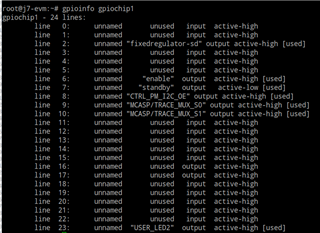Hello.
I would ask TI experts how should I define DTS for j721e board in order to have LD8 and LD9 (connected to IOEXPANDER2 outputs 23 and 24) togling with linux trigger heartbeat.
Doing tests, I am able to make LD8 active defining it as GPIO-hog, but I can not see LD9 togling.
This is the piece of DTS (I have not used overlay, I have just chaged "k3-j721e-common-proc-board.dts")
&main_i2c0 {
pinctrl-names = "default";
pinctrl-0 = <&main_i2c0_pins_default>;
clock-frequency = <400000>;
exp1: gpio@20 {
compatible = "ti,tca6416";
reg = <0x20>;
gpio-controller;
#gpio-cells = <2>;
};
exp2: gpio@22 {
compatible = "ti,tca6424";
reg = <0x22>;
gpio-controller;
#gpio-cells = <2>;
P23-hog {
/* USER_LED2*/
gpio-hog;
gpios = <23 GPIO_ACTIVE_HIGH>;
output-low;
line-name = "USER_LED2";
};
p08-hog {
/* P10 - PM_I2C_CTRL_OE */
gpio-hog;
gpios = <8 GPIO_ACTIVE_HIGH>;
output-high;
line-name = "CTRL_PM_I2C_OE";
};
p09-hog {
/* P11 - MCASP/TRACE_MUX_S0 */
gpio-hog;
gpios = <9 GPIO_ACTIVE_HIGH>;
output-high; /*Ficosa: Activate TRACE lines*/
line-name = "MCASP/TRACE_MUX_S0";
};
p10-hog {
/* P12 - MCASP/TRACE_MUX_S1 */
gpio-hog;
gpios = <10 GPIO_ACTIVE_HIGH>;
output-high;
line-name = "MCASP/TRACE_MUX_S1";
};
};
user1_led{
compatible = "gpio-leds";
label = "user1_led";
gpios = <&exp2 22 GPIO_ACTIVE_HIGH>;
default-state = "on";
linux,default-trigger = "heartbeat";
};
};
I have confirmed CONFIG_LEDS_TRIGGER_HEARTBEAT= y in kernel config.
Any tip?
Thanks



